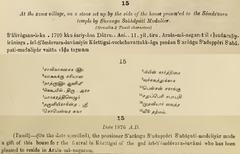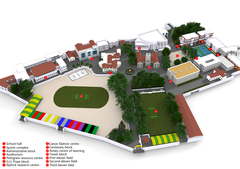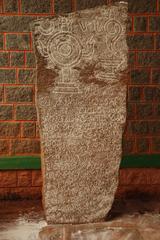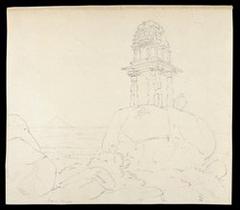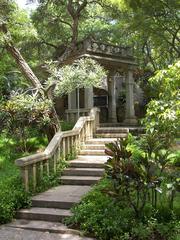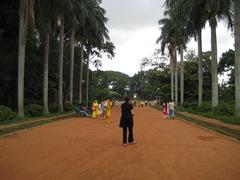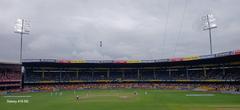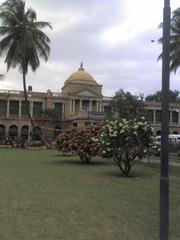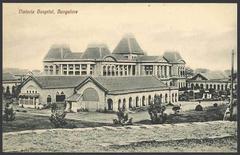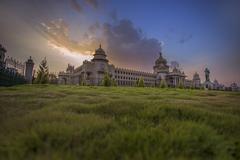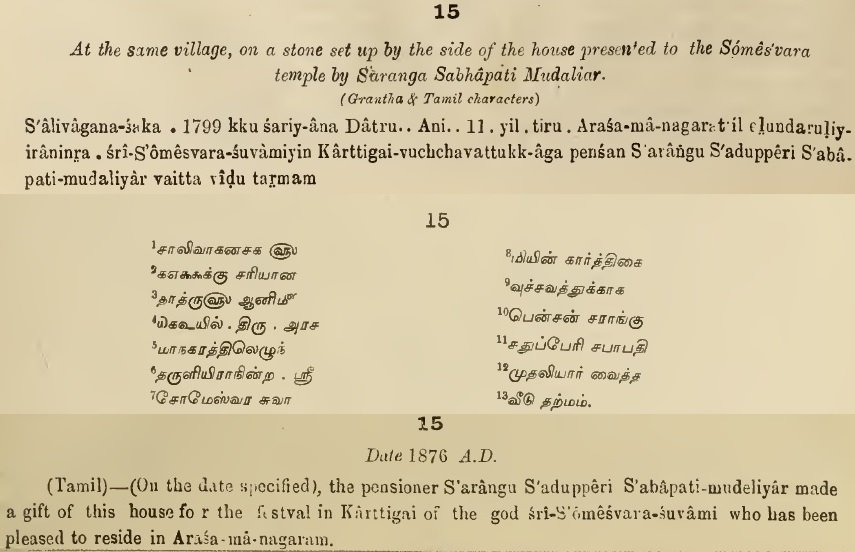
Halasuru Someshwara Temple Visiting Hours, Tickets, and Bangalore Historical Sites Guide
Date: 14/06/2025
Introduction
The Halasuru Someshwara Temple, set in Bangalore’s historic Halasuru (Ulsoor) neighborhood, is the city’s oldest surviving temple and an enduring symbol of its cultural and spiritual legacy. Its roots stretch back to the Chola period (12th–13th century CE), and the temple has been continuously expanded and restored through Hoysala and Vijayanagara dynasties (Indianetzone, Karnataka Tourism). Dedicated to Lord Someshwara (Shiva), the temple’s architecture, legends, and rituals reflect the syncretic artistry and religious devotion of South India.
Steeped in local lore, including the penance of sage Mandavya and the dream vision of Kempe Gowda I (founder of Bangalore) who is said to have been divinely instructed to rebuild the temple, Halasuru Someshwara Temple is an active center for Shaivite worship and a hub for cultural festivities like Maha Shivaratri and Rathotsava (Deccan Herald). This guide presents in-depth information on visiting hours, ticketing, accessibility, travel tips, and nearby attractions, making it a comprehensive resource for anyone seeking to explore Bangalore’s heritage (The Hindu).
Table of Contents
- Introduction
- Origins and Early History
- Vijayanagara and Kempe Gowda Era Renovations
- Architectural Evolution and Features
- Religious and Cultural Significance
- Visiting Hours, Tickets, and Accessibility
- Travel Tips and Nearby Attractions
- Preservation and Heritage Status
- FAQ
- Conclusion
- References
Origins and Early History
The Halasuru Someshwara Temple’s origins are rooted in the Chola period, with its core sanctum (garbhagriha) and granite construction dating back to the 12th–13th centuries CE (Indianetzone, Trawell.in). According to legend, sage Mandavya performed penance here, and the site was once known as Mandavya Kshetra (Trawell.in). Over the centuries, the temple received patronage from multiple dynasties, each leaving their artistic imprint.
Vijayanagara and Kempe Gowda Era Renovations
Major expansions occurred under the Vijayanagara Empire in the 16th century, especially during the rule of Kempe Gowda I and II. Kempe Gowda I, credited as Bangalore’s founder, is associated with the temple’s reconstruction after a visionary dream revealed a buried Shiva Linga and hidden treasures (Indianetzone). This era introduced the grand Rajagopuram (gateway tower) and Dhwajastambha (flagstaff), showcasing a blend of Chola, Hoysala, and Vijayanagara styles.
Architectural Evolution and Features
The temple complex is a showcase of South Indian temple architecture:
- Gopuram (Gateway Tower): The east-facing gopuram is adorned with elaborate sculptures depicting mythological scenes, including Ravana lifting Mount Kailash and the wedding of Shiva and Parvati.
- Mandapa (Pillared Hall): The open and closed mantapas feature intricately carved pillars, yali (mythical lion-like guardians), and floral motifs (Trawell.in).
- Sanctum Sanctorum: The garbhagriha, believed to be original to the Chola period, houses the Shiva Linga.
- Subsidiary Shrines: Shrines within the complex honor Kamakshamma, Arunachaleswara, Bhimeswara, and the Navagrahas, the latter supported by twelve saintly pillars.
- Kalyani (Temple Tank): The ancient stepped tank is a site for ritual purification and community gatherings (Indianetzone).
- Inscriptions: Tamil, Kannada, and Sanskrit inscriptions detail the temple’s history and patrons.
Religious and Cultural Significance
Rituals and Festivals
As a living temple, Halasuru Someshwara Temple follows South Indian Agamic rituals, with daily poojas and special ceremonies during major festivals. Key events include:
- Maha Shivaratri: Night-long vigils, abhishekam (ritual bathing of the Linga), and devotional singing.
- Rathotsava (Chariot Festival): Procession of deities in a grand wooden chariot through the neighborhood.
- Karthika Deepam and Pradosham: Celebrations with oil lamps, prayers, and music (Bangalore Mirror).
Symbolism and Iconography
The temple’s architecture is rich in religious symbolism:
- Gopuram Sculptures: Depict stories from the Ramayana and Mahabharata.
- Navagraha Shrine: Reflects the temple’s role in astrological rituals.
- Yali Pillars and Lotus Medallions: Signify protection and divine presence.
- Temple Tank: Believed to have healing properties and used for purification rituals.
Community Role and Pilgrimage
The temple is a focal point for community events, cultural performances, and social welfare initiatives such as prasadam distribution and educational support. Its inclusive atmosphere welcomes people from diverse backgrounds, making it a place of interfaith dialogue and cultural exchange (Karnataka Tourism).
Visiting Hours, Tickets, and Accessibility
- Opening Hours: 6:00 AM – 12:00 PM and 4:30 PM – 8:30 PM daily. Some sources list slightly extended hours for evening aartis.
- Entry Fee: There is no entry fee; donations are welcome.
- Accessibility: The temple is wheelchair accessible, with ramps and support available for differently-abled visitors.
- Dress Code: Modest attire is expected; shoes must be removed before entry.
- Photography: Allowed in outer areas, but restricted within the sanctum. Always check for signage or consult temple staff.
Travel Tips and Nearby Attractions
- How to Reach: Centrally located in Halasuru, accessible via Halasuru Metro Station (Purple Line), BMTC buses, and taxis. Parking can be limited; public transport is recommended.
- Nearby Attractions: Ulsoor Lake, Bangalore Palace, MG Road, Lalbagh Botanical Gardens, and Commercial Street.
- Best Time to Visit: October to March for pleasant weather; early mornings are peaceful.
- Duration: Allocate 1.5–2 hours for a relaxed visit.
Preservation and Heritage Status
The temple is a protected monument under the Archaeological Survey of India (ASI Bengaluru Circle). Ongoing conservation efforts focus on its sculptures, inscriptions, and murals. The temple’s management organizes educational workshops and heritage walks to foster public awareness and engagement.
Frequently Asked Questions (FAQ)
Q: What are the visiting hours?
A: 6:00 AM to 12:00 PM and 4:30 PM to 8:30 PM daily.
Q: Is there an entry fee?
A: No, entry is free. Donations are appreciated.
Q: Is the temple wheelchair accessible?
A: Yes, with ramps and assistance available.
Q: Can I take photographs?
A: Photography is allowed in outer courtyards; restricted inside the sanctum.
Q: How do I reach the temple?
A: By Halasuru Metro (Purple Line), BMTC buses, or taxi. Parking is limited.
Q: What are the major festivals?
A: Maha Shivaratri, Rathotsava, Karthika Deepam, and Pradosham.
Visual and Media Suggestions
To enhance your visit, explore virtual tours and high-resolution images of the temple’s gopuram, mantapa, and intricate carvings. Use alt tags like “Halasuru Someshwara Temple gopuram at sunrise” and “Lotus medallion ceiling artwork.”
Conclusion
The Halasuru Someshwara Temple is not just a place of worship but a vibrant symbol of Bangalore’s layered history and living traditions. From its Chola-era origins and Kempe Gowda’s renovations to its role as a thriving spiritual, cultural, and architectural landmark today, the temple offers a rich, immersive experience to every visitor. Its free entry, accessible facilities, and proximity to other attractions make it an essential stop for history enthusiasts, devotees, and tourists alike.
For a deeper experience, consider guided tours and festival visits. Download the Audiala app for curated audio tours, real-time event updates, and more insights into Bangalore’s heritage. Stay connected with us on social media for the latest news and travel tips.
References
- Halasuru Someshwara Temple: Visiting Hours, Tickets, and Bangalore’s Oldest Historical Site, (Indianetzone)
- Exploring the Halasuru Someshwara Temple: Visiting Hours, Tickets, and Cultural Heritage of a Bengaluru Historical Site, (Karnataka Tourism)
- Halasuru Someshwara Temple: A Timeless Legacy, (Deccan Herald)
- Halasuru Someshwara Temple: A Heritage Jewel, (The Hindu)
- Halasuru Someshwara Temple, (ASI Bengaluru Circle)
